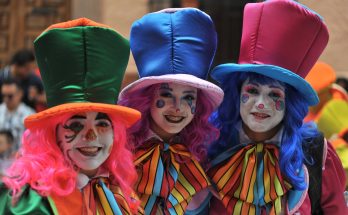By Martin Buen Viaje
Since time immemorial, people have measured time by the movements of the sun. Later came the water clock and the hourglass—inaccurate, but useful. Eventually, monumental clocks were placed in the upper and outer parts of churches, but before those, time was designated by the number of tolls of the bells and were known as “canonical hours.” During the Middle Ages the bells indicated the different times when one had to pray. Then came wristwatches, which were wind-up or eventually battery-powered. Today, we can even measure time on our mobile phones.
Legend has it that a town without a bell clock is a mute town. For us, children of haste and commitments, it is important to know the time precisely, to attend to the different tasks of the day, and to give ourselves the pleasure of eating with the family, arriving at an appointment, or starting a break. Without a watch we would be in limbo.

I had the honor of meeting Raúl Vázquez, a native of San Miguel de Allende, known as «the medical guardian» of the monumental clock of the San Miguel Arcángel parish, which is located on the tower of the Santa Escuela. He has been winding and maintaining it for more than 20 years. Today he is passing the baton to his son Daniel, who will continue the legacy of his father and of five generations that preceded him.

This jewel of engineering and local pride is of French origin, which disputes the notion that Switzerland has the best watchmakers in the world. This relic was manufactured over 121 years ago and continues to give the exact time. Three of these machines were made then, and two were broken during World War II; therefore, we have the luxury of preserving this one-of-a-kind engineering marvel, a true heritage to be preserved. Raúl says that one gram of each piece of the clock costs the equivalent of 10 grams of gold! At the time of its creation, French engineers used a combination of gold, silver, bronze, and nickel to make these engineering jewels. This was an alchemist-level alloy, with such quality that no part ever needs to be changed. This is also true for the bells, which are still intact, ringing every 15 minutes for more than half a century, every day, giving the exact time with a minimum amount of maintenance.
It is a mystery who originally bought the clock. It is known that the distinguished Casa Esmeralda—the first monumental clock manufacturing house in Latin America, based in Puebla—brought it from Europe by ferry, and on September 16, 1901, at midday mass, they played the first chimes. After many years, Norman Bengman, a German watchmaker came to take care of it. He passed on that duty to his daughter Carmen, and she passed it to Raúl, who now gives the duty to his son Daniel.
Daniel invited me to experience the winding of this clock. Its current location is the Santa Escuela, but this is where the town hospital used to be. The tower was built by Don Zeferino Gutiérrez, the same mason who built the current façade of the Parroquia, one of the most photographed structures in the world. Every week the guardian is in charge of climbing to the top of the tower to wind the clock and see if it requires any maintenance.

Daniel told me the amazing story of his father’s life, worthy of a book. His father, Raúl, was «on the street» from the age of 12, attempting to survive. Raul himself told me that he slept on the streets. He always tried to be clean, so he carried a piece of soap with him everywhere to wash his clothes and bathe in the waters of El Chorro. He also carried a saltshaker with him at all times and went to the avocado grove, where he says he always found food in abundance and for free as it fell from the trees. For dessert, he ate zapotes, also coming from the fruit trees. This is what he ate daily and then cleaned up to show up at work. At that time San Miguel was a paradise. Before becoming a watchmaker, Raul did a lot of different types of work. He was an apprentice of almost every craft: carpenter, blacksmith, welder, waiter, restaurateur, and dishwasher.
In those days there was not a single car in the town. There were no banks, and everyone walked. Some lucky ones moved on horseback or tractor. Then, at the age of 19, he met his girlfriend. He told me, proudly, that she had several suitors, and he had to assert himself among several men who, moreover, were older than him. How did he get her to choose him? Well, as a good survivor of the streets, he knew the art of street fighting. He fought like a wild dog when necessary, so everyone agreed with him. He married the girl, María Esther, in 1962, and she is still his wife, life companion, friend, and confidant. Together they built a family.
Someone who valued this attribute of being a “street school graduate” was Jorge Redondo. He was the owner of a restaurant called “El Patio,” the first in San Miguel. He approached that young man, who was 20 years old at the time, and told him: “Raúl, although you have never been a manager, I feel that you have the potential to be a leader to take charge of my restaurant.”
«I accept,» replied the boy, without hesitation.
Shortly after, Raúl earned the experience he needed and became second in command of the restaurant, having more than 50 people in his charge. It was a large space that could accommodate more than 150 people.
In the golden years, he served Father Mojica at the restaurant, a renowned tenor and actor in Hollywood. Mojica was one of the first and most important promoters of San Miguel. He eventually became a priest and moved to Peru, but he always supported San Miguel de Allende and was instrumental in bringing the American artist Sterling Dickinson to the city. Mojica also founded orphanages, one of them still here in colonia Mexiquito.
One day, Mojica arrived at the restaurant accompanied by eight friends. They had eggs and bacon, a Mexican-style breakfast, with homemade rolls. He asked Raúl to accompany them and when the bill arrived, Raúl wouldn’t let him pay. He told him, “This one is paid by God. Don’t worry, father.»
During the many years that he ran the restaurant he was also visited by Cantinflas, who sang, danced, and told jokes. Chavela Vargas also came and happened to be carrying her guitar. She gave a great show right there, leaving everyone happy. The most famous bullfighters of the time passed through the restaurant, along with the Cuban-Mexican boxer «Mantequilla» Nápoles, Agustin Lara, and many more. In those days there were no cell phones, and there were only 100 phone lines installed in the city. Raúl knew the numbers and names by heart; thus, he met almost everyone in the town.
Then he realized that he was tired of working nights, of being serving a restaurant 24/7. His brother-in-law, a watchmaker, convinced him to go work with the family. Within a few months, Raúl was already assembling, disassembling, and repairing watches with incredible precision. This was a skill that other watchmakers took up to five years to acquire. Many watchmakers moved to the United States to work there, so he set up his own watch shop, simply called “Relojería Raúl,” at Orizaba 16, in San Antonio. More than 30 years have passed since then. Today his children maintain the shop. The indefatigable Raúl built several apartments for his relatives in the area, with his own hands.

As the expert that he is, Raúl told me that such prestigious watch brands as Cartier, Omega and Rolex no longer have the quality they used to since they are now made in China. There are few good watchmakers and watches left, “like the old ones,” in the world. His is a specialty almost on the verge of extinction. In San Miguel, there are only two houses where watches are repaired.
It was a great privilege for me to be able to climb and wind up the time of San Miguel. But my greatest honor was to meet this great being and his family, and to be able to share this story of his life with you.
We must be attentive to the second hand of life that always gives us unforgettable moments.




